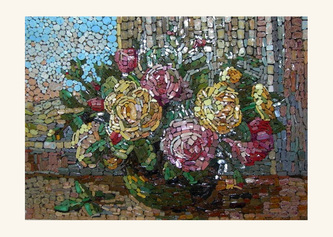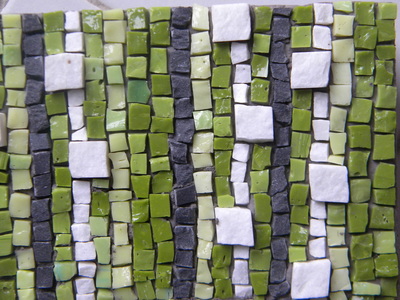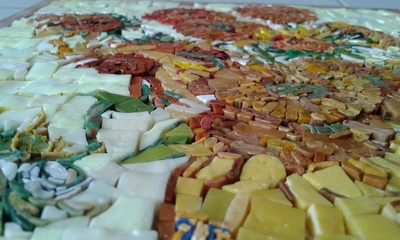|
"There are very few human beings who receive the truth, complete and staggering, by instant illumination. Most of them acquire it fragment by fragment, on a small scale, by successive developments, cellularly, like a laborious mosaic." - Anais Nin
|
Megan's mosaic work spans a variety of fields from archeological restoration to fine art and now towards the contemporary interpretation of this art form through micromosaic jewelry.
The video below offers an intimate look into her process. |
MicromosaicMicromosaic is a technique developed in the 18th century by the mosaicists of the Vatican. In order to create mosaic copies of the famous alterpieces in the basilica of St Peter’s a vast range of colors was needed. The search for these colors resulted in the creation of mother tints or in other words colored glass paste with a high percentage of coloring oxides. These colors are melted in a crucible with a flame and mixed. The mass of molten glass in then pulled into long thin rods (the cross section of which can be round, square, triagular, linear or curved). Colors can be mixed in a way to achieve many different effects and the range of possible colors is almost limitless. The rods are then cut with a diamond file and inserted into a special kind of putty made of travertine powder, slaked lime putty and linseed oil. The oil putty dries slowly which allows the mosaicist time for slow, detailed work.
Micromosaic is ideal for creating reproductions of famous paintings and small precious objects. In fact during the 18th and 19th centuries, the technique of micromosaic reached its highest levels in Rome through the production of jewelry and souvenirs for aristocratic “Grand tour” travelers. |
Mosaico FilatoIl mosaico filato o mosaico minuto viene sviluppato nel XVIII secolo dai mosaicisti del Vaticano. Per eseguire copie delle pale d’altare della Basilica di San Pietro in mosaico serviva una vasta gamma di colori. Le ricerca per queste tinte ha portato alla realizzazione delle madretinte oppure pasta vitrea ad alto contenuto di ossidi coloranti. Queste tinte vengono fuse in un crogiolo alla fiamma, mischiate e poi la massa vetrosa viene tirata in filo a formare bacchette sottili di sezione tonda o quadrata. I colori possono essere mischiati o messi insieme in varie modo per creare diversi effetti e la gamma di tonalità raggiungibili è vastissima. Queste bacchette poi vengono tagliate con una limetta e inserito nello stucco. Lo stucco usato e uno stucco ad olio fatto di polvere di travertino, grassello di calce e olio di lino. Lo stucco si indurisce lentamente cosi permettendo una lavorazione lenta necessario per lavori piccoli e dettagliati.
Il mosaico filato è ideale per la produzione di quadri piccoli e raffinati come copie di dipinti famosi e anche oggetti preziosi. Infatti nel XVIII e XIX secoli si facevano gioielli di tutti tipi destinati ai viaggiatori aristocratici come ricordi di Roma. |
Traditional MosaicThe technique of mosaic, developed thousands of years ago in Mesopotamia, found its first real diffusion in the Greek and Roman world and flowered in the Byzantine and medieval era. Today artists and craftsmen still use much the same technique to decorate and add beauty to floors and walls in homes, churches and public spaces.
The first materials used were terracotta and pebbles. In the Hellenistic world stone and marble and glass paste (smalti) cut with a hammer and hardie were used and they remain the most prestigious materials today. Once the tesserae were cut they were inserted directly into the mortar or adhesive, creating a surface texture full of movement, light and shadow. Over the centuries different techniques have been developed- the tesserae can be applied indirectly which results in a flat, smooth surface or a temporary support can be used such as clay or lime. The direct method however remains the one which best highlights the beauty of the marble and smalti. |
Mosaico TagliatoLa tecnica del mosaico si e sviluppata migliaia di anni fa in Mesopotamia, trovando una prima vera diffusione nel mondo greco e romano per poi rifiorirsi nell’età bizantina. Fino ad oggi artisti ed artigiani hanno usato essenzialmente la stessa tecnica per decorare ed abbellire pavimenti e pareti di case, chiese e spazi pubblici.
I primi materiali usati erano terra cotta e sassi. Nel mondo ellenistico si diffonde l’uso di marmi e pasta vitrea tagliati con la martellina e tagliolo. Rimangono oggi i materiali più prestigiose. Le tessere una volta tagliate venivano inserite direttamente nella malta di allettamento creando una superficie movimentata, ricca di ombre e riflessi di luce. Nei successivi secoli si sono sviluppate altre tecniche. Si può anche applicare le tessere indirettamente, che risulta in una superficie piana e liscia. Oppure su un supporto temporaneo come la calce o l’argilla. Insomma ci sono varie modo di eseguire un mosaico ma quello diretto con tessere tagliate a mano sfrutta al meglio la bellezza della pietra e dei smalti. |
Religious Art |
Arte Sacra |
















